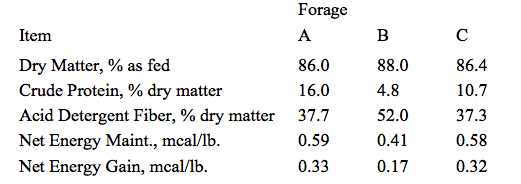While they may seem confusing, the numbers in an forage analysis can tell you a lot about what you’re feeding your cattle. And you don’t need a nutritionist with a PhD to use them.
January 25, 2018

By Justin Waggoner
What’s the reason to get a forage analysis? So we know the nutritional value of what our cattle are eating and can adjust the ration accordingly, right?
That is possible by just watching the body condition of our cattle. But if you’re looking at them every day or so, you can miss slight changes. And by the time the cows show big changes in body condition, it’s way past time to make changes in their diet.
Which brings us back to forage testing. That effort, however, is occasionally viewed by cattle producers as an exercise with limited practical application that generates numbers only a nutritionist with advanced study in analytical chemistry can discern. Yet, practical application is the fundamental reason we evaluate forages and feedstuffs.
The objective of analytical testing of forages and feedstuffs is to improve our ability to meet the animal’s nutrient requirements, and better estimate animal performance. One of the easiest ways we can utilize the numbers resulting from forage analysis is to strategically manage a hay inventory.
Almost every cattle operation has a number of different types of hay in their hay inventory. Let’s assume a spring-calving cow calf operation has three hypothetical forages summarized in the table below.

All three forages have similar dry matter content (86% to 88% dry matter), but differ in terms of crude protein (CP) content, acid detergent fiber (ADF), and the subsequent energy estimates (Net Energy Maintenance, NEm; and Net Energy Gain, NEg) derived from ADF. The ADF number represents the amount of cellulose and lignin within the forage and is inversely correlated with the digestibility of the forage. So more lignin in the forage means it is less digestible.
Forage B has the greatest ADF content, which corresponds to the lower NEm value reported. The ADF and CP content of forage B also suggests it is a relatively mature lower-quality forage as ADF generally increases and CP decreases as forages mature. Forage A and C have similar ADF content, but forage A has a greater CP content than forage B.
The application and use of the forage analyses results does require an estimate of animal nutrient requirements. For this example, I will use the protein requirements of beef cows and one of the rules of thumb that is used to evaluate the diets of mature beef cows to illustrate how the forage analysis results could be used to manage a hay inventory.
The dietary crude protein requirements of mature, reproducing beef cows can be summarized by the numbers 7, 9, and 11. The dietary CP requirements of a pregnant, non-lactating beef cow can be met by a diet that contains approximately 7% CP; the CP requirements of a cow during the third trimester require a diet that contains approximately 9% CP; and once the cow has calved, the diet should contain 10 to 11% CP.
This is a general rule, and there are a number of factors such as cow body condition and forage availability that also must be taken into account. The CP content of our three forages ranges from 4.8 to 16%. Forage B has the lowest CP content and would not supply enough CP to meet the requirements of non-lactating pregnant cow (about 7%). However, if forage B was used in combination or supplemented with either forage A (16% CP) or C (10.7%), it could be utilized.
Forage C matches well with the 9% and 11% CP required by third trimester and lactating cows post-calving, respectively. Forage A, which contains 16% CP, exceeds the dietary requirement of a lactating cow if fed alone. However, forage A could be used in combination with either forage B or C as supplemental source of protein or even energy if fed with forage B.
There are many combinations of these forages that could be used to match the specific requirements of the cows without over or underfeeding CP depending on the supply of each forage in the operation’s inventory and body condition of the cows. Thus, you don’t have to be a nutritionist or have advanced study in analytical chemistry to use the results of a forage test, just a working knowledge of what the numbers mean and animal requirements.
Waggoner is an Extension beef specialist with Kansas State University, based in Garden City.
You May Also Like



